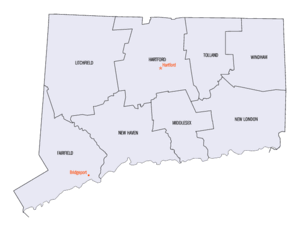
Back قائمة مقاطعات كونيتيكت Arabic Counties in Connecticut BAR Llista de comtats de Connecticut Catalan Rhestr o Siroedd Connecticut Welsh Liste der Countys in Connecticut German Anexo:Condados de Connecticut Spanish Zerrenda:Connecticuteko konderriak Basque Luettelo Connecticutin piirikunnista Finnish Comtés de l'État du Connecticut French Contaetha in Connecticut Irish
| Counties of Connecticut | |
|---|---|
 | |
| Location | State of Connecticut |
| Number | 8 |
| Populations | 116,418 (Windham) – 957,419 (Fairfield) |
| Areas | 369 square miles (960 km2) (Middlesex) – 920 square miles (2,400 km2) (Litchfield) |
| Government |
|
| Subdivisions |
|

There are eight counties in the U.S. state of Connecticut.
Four of the counties – Fairfield, Hartford, New Haven and New London – were created in 1666, shortly after the Connecticut Colony and the New Haven Colony combined. Windham and Litchfield counties were created later in the colonial era, while Middlesex and Tolland counties were created after American independence (both in 1785). Six of the counties are named for locations in England, where many early Connecticut settlers originated; Fairfield County was named after the salt marshes that bordered the coast, while New Haven County was named for the New Haven Colony.[1]
Although Connecticut is divided into counties, there are no county-level governments, and local government in Connecticut exists solely at the municipal level.[2] Almost all functions of county government were abolished in Connecticut in 1960,[3] except for elected county sheriffs and their departments under them. Those offices and their departments were abolished by an act of the state legislature effective in December 2000. The functions the county sheriffs' departments played were assumed by the newly organized State Marshal Commission and the Connecticut Department of Corrections.[4]
These counties are used in legacy geography, such as identifying land, national statistics, and personnel rostering and court jurisdictions in the state's judicial and state marshal system. However, the three most populous—Fairfield, Hartford and New Haven—are as to many types of jurisdiction subdivided.[5]
In 2019 the state recommended to the United States Census Bureau that the nine Councils of Governments replace its counties for statistical purposes. According to the Census Bureau, "Connecticut's COGs/Planning Regions have the authority to carry out administrative functions that are typically found among counties in other states."[6] This proposal was approved by the Census Bureau in 2022, and will be fully implemented by 2024.[7]
Cite error: There are <ref group=lower-alpha> tags or {{efn}} templates on this page, but the references will not show without a {{reflist|group=lower-alpha}} template or {{notelist}} template (see the help page).
- ^ Clark, George Larkin (1914). A History of Connecticut: Its People and Institutions. G. P. Putnam's Sons. p. 1.
a history of Connecticut.
- ^ An Overview of County Government Archived July 8, 2008, at the Wayback Machine, National Association of Counties website, accessed January 5, 2008
- ^ https://www.cga.ct.gov/PS98/rpt%5Colr%5Chtm/98-R-0086.htm#:~:text=Because%20the%20state%20and%20local,a%20viable%20source%20of%20government. "Because the state and local governments had historically wielded substantial authority within Connecticut, county governments never achieved the authority needed to gain a stronghold as a viable source of government."
- ^ "State Marshals Directory - CT Judicial Branch".
- ^ "Connecticut Judicial District Map". jud.ct.gov. Retrieved February 24, 2021.
- ^ "Proposed Change to County Equivalents in Connecticut" (PDF). US Census Bureau.
- ^ https://portal.ct.gov/Office-of-the-Governor/News/Press-Releases/2022/06-2022/Governor-Lamont-Announces-Census-Bureau-Approves-Proposal-for-Planning-Regions Governor Lamont Announces U.S. Census Bureau Approves Proposal for Connecticut's Planning Regions To Become County Equivalents